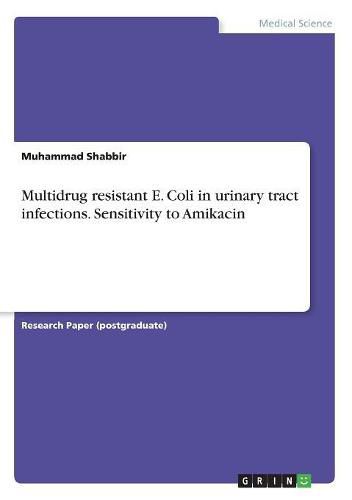Readings Newsletter
Become a Readings Member to make your shopping experience even easier.
Sign in or sign up for free!
You’re not far away from qualifying for FREE standard shipping within Australia
You’ve qualified for FREE standard shipping within Australia
The cart is loading…






Research Paper (postgraduate) from the year 2017 in the subject Medicine - Other, grade: -, language: English, abstract: Urinary tract infection (UTI) is the commonest bacterial infection worldwide resulting from the invasion and multiplication of bacteria in urinary tract. It is more common in females due to short urethra and close proximity with anal canal. It can be mild like cystitis to severe leading to septicemia and death. Escherichia coli(E. Coli) is the leading organism responsible for UTI. Resistance to antibiotics is on rise particularly in developing countries where no antibiotic policies are made. Multidrug resistant (MDR) strains of E. coli are emerging which has made the use of many antibiotics inappropriate. Determination of MDR strains and their susceptibility to amikacin was determined in this study. Objectives: The main objectives were to determine the frequency of MDR strains of E. coli causing UTI and to determine their sensitivity to amikacin. Material and methods: Study design: Descriptive cross sectional Study duration: From 21st August 2015 to 30th June 2016. Setting: Department of medicine Khyber Teaching Hospital, Peshawar. Sample size: Sample size was 179. Results: Out of 179 patients with positive urine culture for E. coli, infection was more common in females, 116(64.8%) were females, 63(35.2%) were male with a male to female ratio of 1:1.84, high prevalence of drug resistance, MDR strains were isolated from 155(86.6%), which showed a sensitivity of 92.25% to amikacin. Conclusion: Drug resistance is on rise with a trend towards prevalence of multidrug resistant strains in the community, cautious and appropriate use of antibiotics is advised.
$9.00 standard shipping within Australia
FREE standard shipping within Australia for orders over $100.00
Express & International shipping calculated at checkout
Research Paper (postgraduate) from the year 2017 in the subject Medicine - Other, grade: -, language: English, abstract: Urinary tract infection (UTI) is the commonest bacterial infection worldwide resulting from the invasion and multiplication of bacteria in urinary tract. It is more common in females due to short urethra and close proximity with anal canal. It can be mild like cystitis to severe leading to septicemia and death. Escherichia coli(E. Coli) is the leading organism responsible for UTI. Resistance to antibiotics is on rise particularly in developing countries where no antibiotic policies are made. Multidrug resistant (MDR) strains of E. coli are emerging which has made the use of many antibiotics inappropriate. Determination of MDR strains and their susceptibility to amikacin was determined in this study. Objectives: The main objectives were to determine the frequency of MDR strains of E. coli causing UTI and to determine their sensitivity to amikacin. Material and methods: Study design: Descriptive cross sectional Study duration: From 21st August 2015 to 30th June 2016. Setting: Department of medicine Khyber Teaching Hospital, Peshawar. Sample size: Sample size was 179. Results: Out of 179 patients with positive urine culture for E. coli, infection was more common in females, 116(64.8%) were females, 63(35.2%) were male with a male to female ratio of 1:1.84, high prevalence of drug resistance, MDR strains were isolated from 155(86.6%), which showed a sensitivity of 92.25% to amikacin. Conclusion: Drug resistance is on rise with a trend towards prevalence of multidrug resistant strains in the community, cautious and appropriate use of antibiotics is advised.